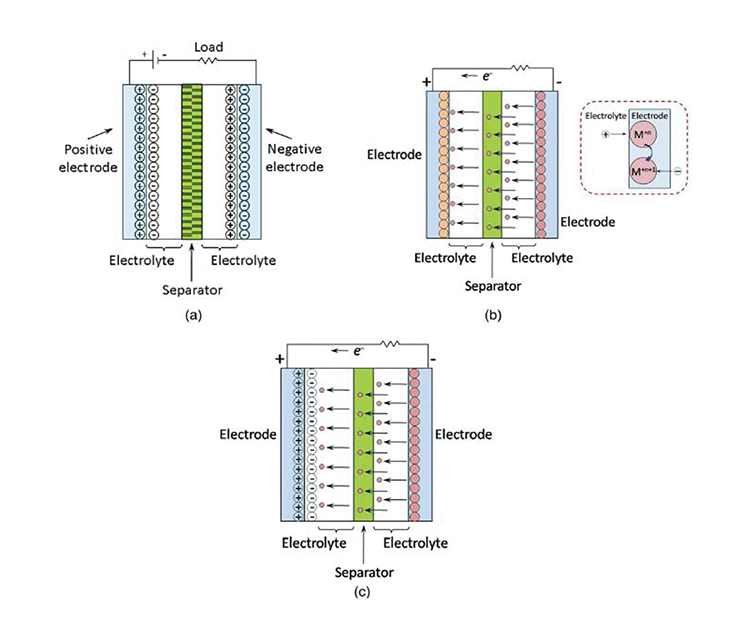The structure of supercapacitor(also called super capacitor, ultracapacitor, gold capacitor and electric double layer capacitor-EDLC) is similar to that of lithium-ion battery, which is assembled in order of positive pole / diaphragm / negative pole. The positive and negative electrodes are all formed by coating the active material on the collecting fluid, drying and compacting. The isolation membrane is placed between the positive and negative electrodes to avoid the short circuit of the positive and negative electrodes. The electrolyte is used as the carrier of ion transport. With the development of interdisciplinary research and extensive application scenarios, there are more and more kinds of supercapacitors.
According to the principle of energy storage, there are double layer capacitors, Faraday pseudo capacitors and hybrid capacitors; according to the electrode materials, there are carbon based capacitors, metal oxide capacitors and conductive polymer capacitors; according to whether the electrode materials are the same electrode materials, there are symmetrical capacitors and hybrid capacitors; according to the types of electrolyte, there are water electrolyte. Capacitors and non water electrolyte capacitors, in which water electrolyte capacitors are divided into acid, neutral and alkaline water electrolyte capacitors. Unlike lithium-ion batteries, which can store and release energy by redox reaction, the energy storage mechanism of supercapacitors is based on the theory of double layers.
As shown in Figure 1, the external electric field causes the positive and negative ions in the electrolyte to be arranged in a directional way on the solid-liquid interface of the negative pole / positive pole of the capacitor respectively. When charging, the excess charge will gather on the surface of the positive and negative pole plates of the capacitor, and the opposite charge in the electrolyte will be arranged in a directional way on the solid-liquid interface of the positive and negative poles, forming a double electric layer; when discharging, the positive and negative pole plates will transfer the charge through the conductive external circuit, and the excess charge will occur. When the amount of charge decreases, the opposite charge of the corresponding solid-liquid interface returns to the electrolyte, thus realizing the energy storage and release. The energy storage mechanism of Faraday pseudocapacitor includes not only the energy storage mode of double electric layer capacitor, but also the energy storage mode of redox, that is, the ion is adsorbed on the surface of the active material on the positive and negative plates or embedded in the active material, and redox reaction occurs with the surrounding material to realize the energy storage. This mode has no material phase change, which is different from the lithium ion in the positive and negative electrodes of lithium-ion batteries. Embedding and deblocking between.
Fig. 1 Schematic diagrams of different types of supercapacitors:
(a) double layer supercapacitors,
(b) faraday pseudopotential supercapacitors,
(c) hybrid supercapacitors
Based on the above principles, compared with the traditional rechargeable battery, the demand of super capacitor for electrode materials has its own unique characteristics, mainly including high specific energy, high specific power and long cycle life. As far as the properties of materials are concerned, they need to have high specific surface area, good conductivity and adsorption properties. Carbon based electrode materials have the above advantages, and the raw materials are rich and cheap, the preparation process is simple, the pore state is easy to adjust, the chemical properties are stable, the thermal conductivity is good, the specific surface area is high, the cycle performance is excellent, and it can be used as the composite of the substrate, metal oxide and conductive polymer, and it is the most widely used and the most mature commercial super capacitor electrode materials.














